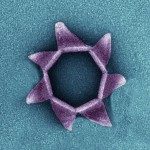Link to Pubmed [PMID] – 17293019
Biochimie 2007 Apr;89(4):427-46
The DNA topoisomerases are essential for DNA replication, transcription, recombination, as well as for chromosome compaction and segregation. They may have appeared early during the formation of the modern DNA world. Several families and subfamilies of the two types of DNA topoisomerases (I and II) have been described in the three cellular domains of life (Archaea, Bacteria and Eukarya), as well as in viruses infecting eukaryotes or bacteria. The main families of DNA topoisomerases, Topo IA, Topo IB, Topo IC (Topo V), Topo IIA and Topo IIB (Topo VI) are not homologous, indicating that they originated independently. However, some of them share homologous modules or subunits that were probably recruited independently to produce different topoisomerase activities. The puzzling phylogenetic distribution of the various DNA topoisomerase families and subfamilies cannot be easily reconciled with the classical models of early evolution describing the relationships between the three cellular domains. A possible scenario is based on a Last Universal Common Ancestor (LUCA) with a RNA genome (i.e. without the need for DNA topoisomerases). Different families of DNA topoisomerases (some of them possibly of viral origin) would then have been independently introduced in the different cellular domains. We review here the main characteristics of the different families and subfamilies of DNA topoisomerases in a historical and evolutionary perspective, with the hope to stimulate further works and discussions on the origin and evolution of these fascinating enzymes.


